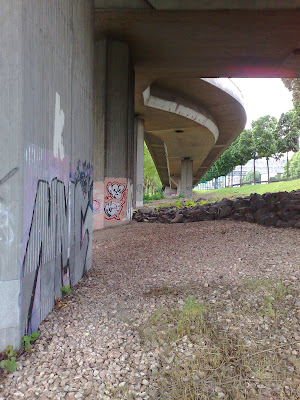2009-05-31
Rusty twins
As much a symbol of Lorraine as of the Saarland. And the economics would appear to be similarly unrosy.
2009-05-30
No window left unbroken
Carreau Wendel, an old coal mine in Petite Roselle, France, now the home of a museum and a minor tourist attraction. Petite Roselle is like Grosbliederstroff: it has a similarly named twin just the other side of the border - Großrosseln, where there is also a disused coal mine, which is not so photogenically abandoned.
2009-05-29
Concrete curve
Autobahn A620, the main traffic artery of Saarbrücken, creates its own concrete landscape along the south bank of the Saar. There are plans (Stadtmitte am Fluss) to bury this autobahn in a tunnel, changing the aesthetics, dampening the noise and sparing the autobahn from the regular flooding it now suffers.
2009-05-28
Rusty tentacle
Yes, they also dig up roads in Saarbrücken. And here is an example of some of the metallic lifeforms they find.
2009-05-27
Bunker 316
Part of the Westwall (Siegfried Line), the series of over 18,000 bunkers, tunnels and tank traps built by Hitler in the 1930s from the Swiss to the Dutch borders. Most have now disappeared and this is the only one left in Saarbrücken. The interior can be seen in the Saar Lorraine Location Guide.
2009-05-25
Brebach through the trees: through the wilderness of the St Arnualer Wiesen you can see the typical whitewashed houses of Brebach. There is no path down to the water in the foreground. It seems almost untouched.
2009-05-23
Blue bridge from a green meadow: the bridge in question is the Ostspange and the meadow is the Sankt Arnualer Wiesen, which is a little peninsula made from the rubble of bombed buildings and sediment dredged from the Saar. The town had great plans to develop this area with a market and sports arena, but the plans came to nothing and since 1984 it has officially been given over to the bees and the butterflies as a recognised nature reserve.
2009-05-22
Remains of Empire: fourth century stones from a Roman fortress.
A Gallo-Roman settlement arose here in the first century AD at the crossing point of two important roads - Worms-Metz and Strasbourg-Trier. To improve communications, a stone bridge across the Saar was constructed and in the fourth century work started on a military camp, whose ruins can be seen above. It is thought that the fortress was never fully completed. By the fifth century it had been destroyed and the bridge, too, fell into disrepair. For ten centuries after that ferries and fords were only way to cross the Saar.
2009-05-20
A symbol of Saarland: although the last remaining pits are scheduled to close and the centuries long mining tradition will be no more.
2009-05-18
Endless iron and graffiti: a bridge across the Saar next to the iron works.
Click the photo to get a larger version and see the rust in its glorious detail.
2009-05-17
The last train has departed: tracks that used to serve the iron works where the saftey sign photo was taken.
2009-05-16
Eigene Vorsicht, beste Sicherheit: own care, best safety.
This is another site in Burbach, where an old iron factory is being redeveloped as offices and warehouses.
2009-05-07
Kunstsilo (Art Silo): this silo can be seen in 2009-02-09, but this time the shot was taken from a boat. After being used in 90's as a great scene for techno parties, it now offers workshops for artists. It has its own web site with links to repurposed silos around the world. Photos of the inside can be found on Urban Culture.
2009-05-01
Rainy layers: lush grass, white tree blossom and dark clouds on a rainy day in Spring. Location: almost exactly on the Franco-German border between Reinsheim and Bliesbruck.
Subscribe to:
Posts (Atom)






























